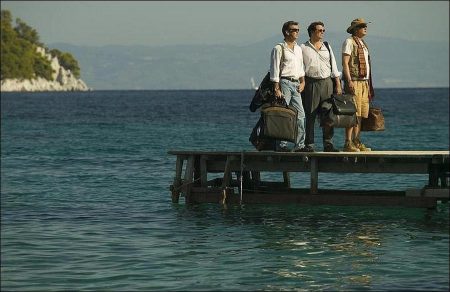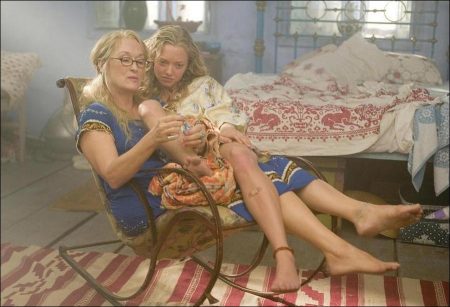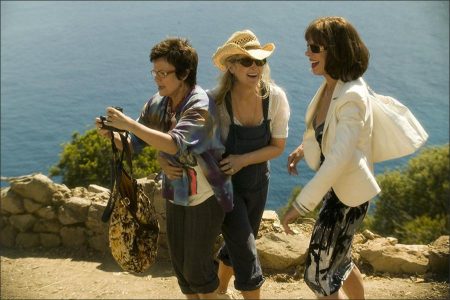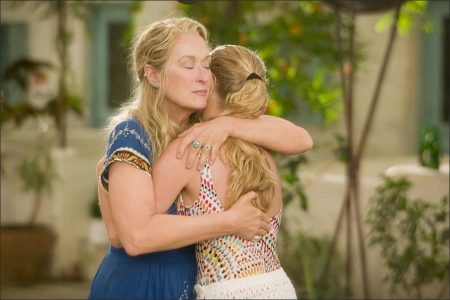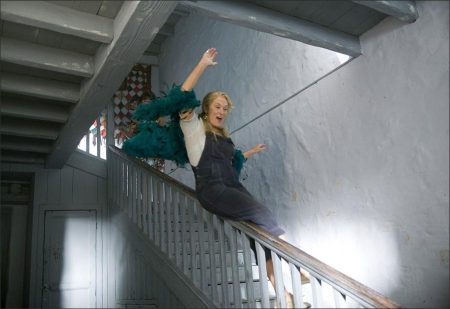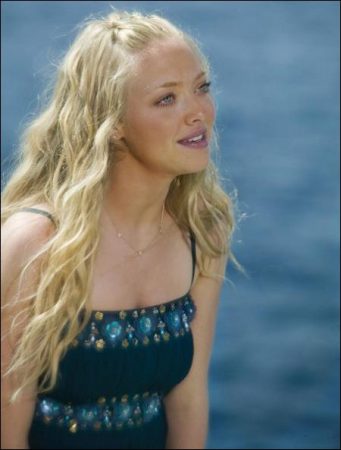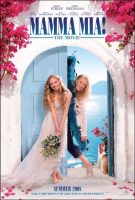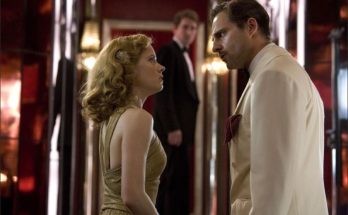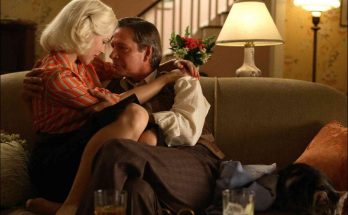I Have a Dream: Mamma Mia! Is Developed
The story of Mamma Mia! began in the ’80s when producer Judy Craymer was working with Benny Andersson and Björn Ulvaeus as executive producer of their first post-ABBA project, Chess. She was immediately smitten with them. “After all, these were the men who had written `Dancing Queen,’ one of the greatest pop songs of all time,” explains Craymer. Inspired by the theatricality of their songs, she was moved to create a musical that would use existing ABBA songs, but one set against an original and exciting new format.
One song in particular, “The Winner Takes It All,” (sung in the movie by Meryl Streep) turned out to be the trigger. Originally titled “The Story of My Life,” ABBA’s greatest break-up song (also the band’s last top-10 hit in the United States) takes the listener on a roller-coaster ride of emotion.
In spite of reassurances that this would not be an ABBA tribute musical or the band’s story, Andersson and Ulvaeus were initially reluctant. So, Craymer began the long campaign of persuading the two to lend their songs to the project. In 1995, her tenacity paid off. They agreed, provided she could come up with a story strong enough to carry the songs…and a writer who could unlock the potential she’d spotted. In 1997, years after she had approached the men behind ABBA, Craymer met playwright Catherine Johnson, whom she believed had the talent and sensibility for the job.
Craymer briefed Johnson, and the producer asked the writer to note how ABBA’s songs fell into two distinct groupings: the younger, more playful and innocent songs such as “Honey, Honey” and “Dancing Queen,” and the more mature, reflective and emotional songs such as “The Winner Takes It All” and “Knowing Me, Knowing You.” Craymer believed the songs suggested a story that could span generations.
Too, Craymer felt Johnson might consider that weddings and holidays were themes suggested by Ulvaeus’ lyrics. Craymer recalls, “I told Catherine you have to forget the songs. It is your source material only, and the story has to work without the songs. It is exactly what she achieved.”
For Johnson, the starting point was to read ABBA’s lyrics from A to Z, build the framework of a stand-alone story and choose only songs that would logically drive her narrative. Still, she felt she must be mindful that the tempo of the songs she used from ABBA’s catalogue complement the action. Not an easy task.
The result was a heart-warming and uplifting story about two generations of women, young love and love the second time around…not to mention friendship, discovering one’s identity and wish fulfilment. Johnson and Craymer felt that the story had universal resonance, with an appeal that crossed age, gender and national boundaries. Just as ABBA’s timeless music and lyrics do.
With a working script, Craymer began the search for a director. She persuaded respected theatre and opera director Phyllida Lloyd to join the company, and Lloyd immediately responded to Mamma Mia! Drawn to the songs, the notoriously calm, methodical director sums, “This was the musical Benny and Björn didn’t realize they’d written.”
Björn Ulvaeus worked closely with Lloyd, Craymer and Johnson, giving feedback on each new draft. More of the crew, including choreographer Anthony Van Laast, were added-along with an “A-list” of stage designers, including Mark Thompson (sets and costumes), Howard Harrison (lighting), Martin Koch (musical supervisor and orchestrator) and Andrew Bruce and Bobby Aitken (sound designers)-and the team workshopped the production in London a year before it was to open.
Of the process, Ulvaeus recalls: “Things were changed, songs were taken in and thrown out. By then, Catherine knew every lyric and was familiar with these hundred songs or so of the catalogue. The ground rule was not to change them, and given that, it is amazing how it still was possible to weave a story.”
Benny Andersson waited until the first preview to sit down and see the production, and was quite moved by how well it turned out. “I think that the biggest surprise for people who go to see it is that whatever they think it is before they go, they come out with a totally different experience,” he says. “The songs are good, but the context in this intelligent, witty way that they put together the old lyrics and used them to bring the story forward was amazing. I’m Catherine Johnson’s biggest fan.”
The first show opened on April 6, 1999, at the Prince Edward Theatre in London, which was deemed a good omen as ABBA had won the Eurovision Song Contest on the same date in 1976. The stage production was given the kind of rapturous reception it has grown accustomed to ever since. Mamma Mia! opened in the U.S. in November 2000 at the Orpheum Theatre in San Francisco. In October 2001, the musical debuted on Broadway, bringing in $27 million in advance ticket sales (one of the highest in theatre history), and, in 2002, the show received five Tony Award nominations. In February 2003, the show opened at the Mandalay Bay Theatre in Las Vegas, and played its 1000th show in June 2005 (becoming one of the longest-running Broadway plays in Las Vegas).
Money, Money, Money: Putting the Creative Team Together
Soon after the show opened in London, several companies expressed interest in making the musical Mamma Mia! into a film. Tom Hanks and Gary Goetzman’s company, Playtone, would ultimately become Littlestar’s (Judy Craymer’s company) producing partner for the film. Executive producer Hanks recalls of seeing the show: “By the twelfth minute, I was standing up singing along with the music.”
But Craymer was in no hurry to translate the musical into a musical romantic comedy for the screen. “Mamma Mia! begged to be a movie,” she said, “but first, I had to get the shows to the point where it was appropriate to make that transition.” There was still much of a journey for Mamma Mia! on the stage, and the team needed to focus on the show and new openings internationally.
In 2003, after Mamma Mia! had opened across Europe, America, Australia and Asia, Craymer felt the time was right to adapt it for the screen. She contacted Gary Goetzman at Playtone again and asked if they would be interested in partnering to produce the film. Happily, Playtone was, and a deal was made.
Provides producer Goetzman: “The most important factor in translating Mamma Mia! to film was to capture the tone, energy and spirit it has on stage. We knew if we could do that, we would make a great movie.” For Goetzman and Craymer, that meant keeping as much of the original formula as possible. He continues, “Our job would be to merely translate what they’d envisioned onto the screen, and it has been seamless.”
From the beginning of the project, he believed that the film could intensify the enormous fun and enjoyment that the show had already established. Goetzman offers, “With film, you can get closer to the characters and focus the audience on what you want them to see. You can enhance the brilliant elements of the play that people all over the world have loved for years.”
Lloyd and Johnson were more than ready to join them in the task. Says Lloyd, “Mamma Mia! was always a movie. It’s set on location on a magical island. In many ways, it was bursting to get off the stage and into the cinema. It has just leapt out.”
For her part, Johnson was up for the challenge of adapting her stage play into a screenplay. “It was an opportunity for me to further explore the emotional core of the story,” she explains. “On stage, if there was a dance number, I could just write `dance number;’ that was it. On screen, I had to actually write in the whole sequence of what happened within that scene and keep the narrative going. So, it’s actually about twice the amount of work I’ve had to do before.”
The challenges of expanding a stage play into a musical romantic comedy was not lost on Johnson. For example, the filmed Mamma Mia! allowed her to take the “Dancing Queen” sequence out of the bedroom stage setup and bring a troupe of women down to the harbour dock. Relates the writer, “We are able to start in one small space and take the scene off to a much larger location.”
Adds Craymer of the potential: “We also show how all the characters get to the island. In the stage, you’re very restricted, whereas in the film, we could follow the journey of how the three possible fathers arrive on the island.”
Shooting her musical film at Pinewood Studios in London on the huge 007 stage and on location in Greece was liberating for the director. In order to further explore the use of space on film, Lloyd actually pre-shot the film with previous cast members from the stage production. “It was really for me to work out certain things about structures of songs and whether the stage choreography really needed to be completely reinvented or thrown out. At the essence of it was getting a camera in my hand and figuring out [when the song tracks came on] when the camera moved and when it didn’t.
“I was determined that the camera language was going to be different for every song,” Lloyd continues, “not just for the sake of it, but so that it would do something different to the audience-according to what the plot required at the moment. I wanted to get inside the scenes, because I’d always been outside them in the theatre. I parked myself right in the middle of a piece, like “Voulez-Vous,” and presented Sophie’s point-of-view with my camera.”
For producer Craymer, it was an exciting prospect to increase the scale of the show, both visually and thematically, with the continued help of the men behind ABBA. “The involvement of Benny and Björn continued to be crucial,” says Craymer. “To have them working in a hands-on way, reworking the music and recording with the actors was an incredibly exciting prospect for us.”
“It has been tremendously joyful, especially collaborating with the actors who have been so incredibly well prepared. It’s a totally uplifting experience,” says Andersson.
Craymer and Goetzman would only agree to the musical film if the core group that achieved success with the stage musical stayed together. Craymer reflects, “There is something we can’t quite put our finger on that we call the `essence of Mamma Mia!,’ or `the Mamma Mia! factor,’ and we have developed a shorthand between us that was necessary to take Mamma Mia! from the stage to the screen.”
Take a Chance on Me: Casting the Film
With an accomplished behind-the-scenes production team, the filmmakers looked to find a cast just as amazing. Craymer had always said songs were the stars of the show, but after she looked around the table at the read-through, she admits, “I had to eat my words!”
Cast in the lead role of Donna was the incomparable Academy Award-winning actress Meryl Streep, known for her dramatic and versatile roles in countless films and considered by many to be one of the greatest living American actors. Mamma Mia! is Streep’s first full-on movie musical, though she has done singing work in Postcards From the Edge and A Prairie Home Companion.
Says Craymer of the production’s choice for Donna: “We had always leant towards Meryl Streep playing the lead character. It was beyond joyful that she said yes to the offer immediately. We knew she had seen the show on Broadway a few years ago, as she’d written a rather wonderful letter to the cast, telling them how much she loved the show and how she’d wanted to get up on stage and feel what it was like to be part of Mamma Mia! Like schoolgirls, we kept this letter.”
“We dreamt of asking Meryl to play Donna,” says director Lloyd. “We knew she sang; we knew she wanted to do a musical. She combines everything that is required. She’s one of those unique actors who can laugh the world’s laughs and cry the world’s tears. That’s what Mamma Mia! needed, and we have it in her.”
Streep had indeed seen the show in New York and recounts, “It was pure joy.” She was drawn to the role for its humanity, its spirit and, of course, the music. “The songs are timeless,” says Streep. “They just enter your body. When I came to learn them, I found I knew every single one. They have amazing hooks and great melodies.”
Streep also responded to the fact that women had created Mamma Mia! and this would be a challenging, physical role that demanded a great deal of stamina. Among other moves, she would have to scale the side of a 40-foot building and sing “Mamma Mia” while balancing precariously on a rooftop. Too, she would sing “Dancing Queen” while performing a series of stunts, which included sliding down banisters to jumping off a jetty and into the sea.
Laughs Streep, “I was told that I was going to climb up the goat house wall while singing `Mamma Mia.’ I thought, `How big could a goat house be?’ The goat house turned out to be this sheer wall. I was basically doing a Spider-Man stunt, and I got in shape really quickly. It was the first week, and I thought, `Whew! I better do my exercises every night.’”
Cast to play the (un)welcome dads were Pierce Brosnan, Colin Firth and Stellan Skarsgård. Says Lloyd, “We’ve got three men with incredible warmth and humour, and an intrinsic understanding of what Mamma Mia! is and what it requires. Each of these actors has the skill to take us on this incredible journey from a place in their lives where they’re all a bit stuck, a bit lost, to their liberation and literally letting their hair down on a magical island.”
As excited as Pierce Brosnan was at being offered the role, he admits to being initially terrified at the thought of having to sing and dance. Brosnan says, “I experienced sheer terror at the idea. I don’t think I have ever been so nervous about a job. In the end, I just surrendered to the whole experience, and had a great time doing it. It’s actually quite exhilarating to sing and to express your emotions that way.” He acknowledges that, in the end, the nerves helped: “Fear will drive you to great lengths to try and get something perfect and meaningful. The months of anxiety paid off.”
“Mamma Mia! has this insidious magic,” says the man cast as Harry Bright, Colin Firth. “It does tend to get to everybody.” Recently seen in Then She Found Me, Firth acknowledges there is something about the musical that is “conducive to abandoning yourself, rather like people do at the end of the show.” Firth responded to several elements of the project: “There’s a real tenderness about the notion of these three grizzled, middle-aged men who find out there’s more to their lives than they thought. The greatest pleasure of doing this has been working with this cast. Little bits of extra inspiration come up just because we’re all having fun.”
Of his director, he continues: “Phyllida has an amazing way of informing moments that don’t seem to have been important, with texture, or using an angle that could make the moment more interesting. It’s wonderfully economic and precise filmmaking.”
Completing the trio is Stellan Skarsgård of the Pirates of the Caribbean franchise, who was intimidated by a different challenge of a musical film: dancing. In spite of being wary of dancing, “something I haven’t done sober in 30 years,” Skarsgård admits, “I enjoyed it enormously and tried to have as much fun as I could. The whole experience has been totally liberating. All you can do is enjoy it and go for it.”
What was most humorous for Skarsgård was the concept of men playing the supporting roles, those conventionally performed by women in male-led films. He laughs, “Nobody is really interested in our psychology. We are the bimbos in the film!”
Cast as The Dynamos are Julie Walters, beloved British star of stage and screen, and Tony Award-winning actress Christine Baranski, one of the musical theatre industry’s most-honoured actresses, who was seen in the filmed production of Chicago. Respectively, they play the pragmatic Rosie and the multi-divorcée Tanya.
Walters accepted the part without hesitation. “I can’t tell you how much I loved the show,” she says. “It has a real irony and wit to it.” Though Walters has experience in singing and was less fazed at the prospect than the actors who play Sophie’s dads, the dancing was another matter. “I beat the floor at home to death practicing the dancing,” she laughs.
Explains Baranski about her interest in making a filmed version of Mamma Mia!: “What holds this together so well is this marvellous story about deep relationships. One of the great challenges and pleasures for me-and Meryl and Julie-was creating this sense of an old and textured friendship. It was easy to connect to Meryl and Julie-they are both awesome women. When they cast this film, they considered actors who would tap into what the filmmakers call `the Mamma Mia! spirit,’ which is an openness, a sense of fun and adventure.”
No stranger to singing and dancing on stage and screen, Baranski underscores the daunting task the cast was about to face: “There’s a tendency to think ABBA songs will be easy to sing-because they’re so catchy perhaps-but they are much more complicated than one would think. They demand a certain style. Benny and Björn are superb musicians, and their harmonies and rhythms are complex. They are very exacting about what they want.”
The filmmakers had very specific ideas about the roles of Sophie and Dominic, and in Amanda Seyfried and Dominic Cooper, they found the embodiment of their young lovers. Explains Craymer: “Finding Sophie was a huge task. She had to be impish, but innocent at the same time. She had to be fun, and she needed to sing really well, of course. Amanda ticked every box; she is our ideal Sophie.”
Seyfried, known to audiences from her standout roles as “weather girl” Karen in Mean Girls and as Sarah Henrickson, daughter of a polygamist in HBO’s Big Love, had previous singing and dance experience. But she would be up against a veritable who’s who of young Hollywood eager to land the part. Seyfried describes being chosen for the role of Sophie as “every girl’s dream.”
The auditioning process was intense. Up against a number of young women, Seyfried’s astonishing vocals distinguished her. Recalls Lloyd of the audition: “Amanda has that completely winning, radiant warmth and an almost childlike youthfulness. She also has a fabulously natural voice that made Benny and Björn ask her to sing tracks she wasn’t even singing in this film. She walked in and, from the first note she sang, you could feel everybody in the room go, `This is it.’”
During her audition process, Seyfried saw the show in Las Vegas and was hooked. “It was fantastic,” she relates. Like others, she acknowledges the timeless quality of ABBA’s songs and relished the opportunity of performing them. Seyfried also admits how excited she was at the prospect of following in the footsteps of the select actresses who had played opposite Streep: “She’s incredible. She’s so aware of how people might react to her presence and did her best to make me feel comfortable. I feel I have learned so much from the opportunity of working opposite her.”
Playing opposite Seyfried is young British actor Dominic Cooper of The History Boys and Starter for 10. The chemistry between his Mamma Mia! fiancée and Cooper was palpable in the screen tests. Says Craymer: “Dominic has a charming yet playful factor. He can sing, and the girls love him. He is perfect in the role of Sky.”
“It’s an incredible cast, and it’s a very exciting project to be a part of,” remarks Cooper. “The fun started during the audition process,” he says, “and has continued ever since. It’s such an exposing thing, to sing. I really admire singers because you can’t hide behind all of your little sneaky acting tricks or speaking, and it’s very revealing.”
About his director, Cooper offers: “She’s incredible with actors. Most of us really need to be guided through this; it’s new territory, and you couldn’t ask for a director who knows her stuff more than she does.”
The positive feelings expressed by the cast were characteristic of the Mamma Mia! experience felt by the stage productions globally. Concludes Craymer: “It has always been very important to me, as a producer, that everyone who’s part of the team has a great time. I believe that vibrancy, that good feeling, also has to come from the screen for the audience to enjoy it.”
The principal cast is supported by actors including Philip Michael and Chris Jarvis as Sky’s best mates, Pepper and Eddie; Rachel McDowall and Ashley Lilley as Sophie’s school friends (now bridesmaids), Lisa and Ali; the inevitable Greek Chorus; and some 20 stags (men) and 20 hens (women).
Cast set and crew hired, it was time to begin principal photography at a refurbished studio and to escape to an exotic, lush Greek isle where anything could happen.
Lay All Your Love on Me: The Music of Mamma Mia!
The leap from stage to screen was a challenging one, not least of all because it was Andersson’s desire that every actor should perform his or her own vocals. Musical director Martin Lowe, who joined the Mamma Mia! team in 1999, says, “It set the bar quite high. Having worked on the stage show, I knew what was required of performers to deliver the songs. The songs demand a great deal of skill and style.”
Lowe was present at cast auditions. “Ultimately, I was hired to serve Benny’s music,” he offers. “I was not about to put my name to something that might compromise that.” During the casting process, Lowe worked in Stockholm with Andersson and the original ABBA band to record the score for the film, which involved using the cast of the Swedish stage production of Mamma Mia! to record the backing vocals for the big ensemble numbers in the film such as “Voulez-Vous” and “Gimme! Gimme! Gimme!”
Lowe’s job gained momentum as the cast was confirmed. He worked with key cast to find each of their keys on phrasing and to give them confidence before going into the studio to record. To nail the best performance, Lloyd took advantage of different song recording options: both prerecording the vocal tracks so that the actors had to lip sync to their own performance, and having the actors sing live on set to a guide track.
Explains executive producer Mark Huffam of the process: “The tradition in musicals is to do a prerecord and then mime. Because we have such fabulous actors in this film, they were given the opportunity to sing live in the more organic numbers. We left the option open, and we’ve done it both ways. We’ve done a lot of playback on all the bigger dance numbers, but on some of the more personal songs, we’ve done them live.”
The cast appreciated the choice. Says Streep: “Working with Benny and Björn on recording the songs was very interesting, as I did it in advance of really knowing who my character was or what her voice was. I found, as we shot the film and recorded live, the voice I was singing in was quite different to the one I was hearing in my earphone. So the voice evolved, and it was great to have the option of doing it live too, as the energy and the physicality of the acting performance dictates how the song is delivered in a way I couldn’t have known when we first recorded it.”
Firth agrees: “It’s tough to sing a song before you establish a character; a song in a musical is not a disembodied thing. It’s part of the narrative and, as such, the performance has to be right for the character. You have to bring the performance to the song or the song to the performance.”
Brosnan commends of his musical director: “Martin instilled such confidence in me. He came out to California; we set up in my office one day and just started banging out the songs. For the next few months, I just listened to them day in and day out, driving the kids to school,” he continues. “When it came time to record, I walked into the studios and there’s Benny and Björn, and there’s Phyllida and Judy…and it’s show time. As for my singing, they just said, `Great.’ They liked what I did, and it was very easy. I wasn’t alone because I had Stellan and Colin right there, equally terrified.”
“I think I’m most proud of Dominic,” Lowe says of the young actor who admits he had “moments of panic” before meeting with his musical director. “He worked so hard. We literally went through each song line by line, and I tried to show him how to sing like a pop singer.”
Fellow countryman Stellan Skarsgård also enjoyed his experience working with the men of ABBA. Of Ulvaeus and Andersson he says: “They’re so calm and very Swedish. Here are two other fellow Swedes just standing there, and they were very nice and encouraging, and they just let me sing on.”
Amanda Seyfried also had Lowe, Ulvaeus, Andersson and Lloyd present during her recordings, but it couldn’t have been more of a freeing experience. “It was so exciting and surreal to work with them. They didn’t direct me too much,” she says. “I had a tone and sound they liked, so they just let me be free with it.”
Lowe points out that many of the songs Seyfried has to sing for the film are tricky, such as the complicated phrasing in parts of “I Have a Dream.” “The line `I believe in angels’ falls on a break and sits in an awkward place in the song,” he provides. “Some women at the audition just couldn’t hit it. Thank the Lord we found Amanda, who just came in and did it. When she walked out of her audition, the camera operator and the sound guy just went, `This is Sophie.’ And they hadn’t spoken all day!”
Adds director Lloyd: “Amanda makes you feel utterly sympathetic and protective toward her, right from the get-go of the movie. She’s instantly lovable, and that’s crucial about Sophie.”
It was an exhausting process for all the cast. The filmmakers took off their hats to the performers for the work that they did. “ABBA music is complex music,” suggests Rita Wilson. “The songs are hard to sing, very melodic and have gorgeous harmonies. It doesn’t become tiring listening to them. There is an exuberance and an unself-consciousness to the music. The songs allow you to act giddy, goofy, sweet, young and silly-just as they are wrapped in deceptively complex melodies.”
Dancing Queen: Choreography in the Film
Mamma Mia!’s choreographer since the beginning, Anthony Van Laast was curious to take the musical from stage to screen. “The challenge for me, both on stage and screen,” says Van Laast, “was to make the choreography narrative-based and character-driven, so that it appears to be improvised and spontaneous. In fact, it is really structured and developed.”
In the early stages of preproduction, Van Laast spent time rehearsing with Lloyd and her troupe of dancers just how exactly to make the dance work on film: which numbers would work, how many dancers were needed, where to position cameras, etc. Van Laast retained some of the original movements from the musical but, overall, mostly re-choreographed the dance for the screen. Such choices were crucial to facilitate working with twice as many dancers and adapting the dances to allow dialogue to continue throughout the film.
To help make the transition seamless, Van Laast suggested casting the majority of the dancers and the stand-ins from the pool of talented original performers of the stage show. Their ability to move gracefully and learn the dance routines would prove an invaluable time-saver, and immensely beneficial to the principal artists who could watch their steps.
Together with associate choreographer NicHola Treherne and assistant choreographer Tim Stanley-both of whom had also worked on the show for a number of years-Van Laast put the actors through the paces, rehearsing for weeks prior to the start of shoot and continuing with workouts and warm-ups every morning once filming commenced.
Having Stanley and Treherne on set helped make the process of staging and choreographing the large number of dancers a good deal easier. “Tim was much on the floor, checking that everything was fine amongst the dancers,” notes Van Laast. “Nichola acted as an intermediary between the dancers and myself, as I was on the monitors. If I saw something that was not working correctly, I’d say to Nichola, `Could you go make sure that that person moves a bit to the left or moves to the right,’ so I got the perfect pictures all the time.”
Though Baranski has had years of experience working on musicals and musical film, she admits that she felt slightly nervous and took up extra dance and movement classes to prepare. “One is always nervous about singing and dancing,” she says, “even if you’re a seasoned musical performer, because it’s a demanding genre. With music, you have to come in on a certain note or a certain rhythm and get your leg up at a certain time or turn or land at a certain time.
“When I heard I got this job, I immediately started doing private pilates and jazz classes, and stretching and going on the elliptical and working up stamina and flexibility,” she continues. “When I got to London, I found out where to take some ballet and jazz classes.”
Laughs Streep: “I’m really doing this to embarrass my 20-something-year-old children. The dancing part will mortify them. They’ll have to move to Alaska or someplace. Just the overalls alone are gonna do it for them.”
Continues Walters: “I’ve just got little wee bits of dancing, but it’s the most amazing dance. I could have gone on shooting it for weeks with these gorgeous male dancers. I’ve had this gorgeous partner, Philip, whipping me round and, of course, dancing with Stellan is really good fun.”
Van Laast acknowledges how exciting it has been to turn his actors into dancers: “They bring something to the movement that is so real. When you work with dancers, it’s so perfect, so fluid, there are no edges. Working with actors, they give the dance character, as opposed to it just being a slick routine. I have learned so much about finding character through movement.”
Our Last Summer: Shooting Mamma Mia!
Following several weeks of music and vocal recordings, six weeks of combined costume fittings, makeup tests and dance rehearsals, the Mamma Mia! shoot began on the newly refurbished 007 Stage at Pinewood in June 2007. The lavish composite set, designed by production designer Maria Djurkovic, gave the filmmakers the opportunity to expand the work that Craymer, Lloyd and Johnson had achieved on stage.
Djurkovic relied on the script as her starting point, and not necessarily the show. “On stage, you’re creating much more of a fantasy,” she explains. The designer exercised artistic license to make this musical world a believable one. “On film,” she continues, “while it was important to maintain a certain theatricality, I had to create a world that was utterly believable and credible.”
It was a daunting task to build a mini village, while keeping in mind that the set would have to integrate credibly with each aspect of the Greek isle’s location shoot, but Djurkovic rose to the challenge. She provides: “The trick to making this work is that it should be visually joyous…it’s a musical. The spiritual bit is happy and joyous and slightly frivolous. But at the same time, the audience has to believe what’s happening.”
Adds producer Goetzman: “Part of the translation of taking stage to film is in the design. We had to figure out how to take the stage set (which spun on a turntable) and turn it into a film experience. Maria did a fantastic job, and I think people will enjoy the beautiful transition to natural, yet stylized, settings.”
The location-scouting trip in Greece helped inform the style and design of Villa Donna, and both Lloyd and Djurkovic responded to the notion of the resort as a restored building. Overseeing an array of designers, carpenters, plasterers and painters, Djurkovic instilled in the team a precise attention to colour, texture and other design details.
After nine weeks of shooting on the Pinewood stages, the unit moved to Greece, where it first shot on the island of Skiathos for five days. Next, it was off to Skopelos for two weeks and, finally, to the mainland in Damouhari for five days. All locations had been determined following an extensive location scout of 21 Greek islands once the project had been green-lit.
Supported by an enthusiastic local crew, the unit faced a number of challenges, including shipping large amounts of equipment, the vagaries of weather, working at sea, a plague of wasps and accommodating a cast and crew of some 210 people on small islands. Lloyd was game for the challenges and says: “We’ve always been excited by changing what we’re doing according to the context. So it’s very much meat and drink to us to be in a more rocky place, or a wetter place and having to adapt to the terrain.”
The director, familiar with the landscape as she had backpacked across Greece when she was 17, expounds upon the challenges that come with shooting on location. While she views the islands as paradise, she says, “You have to be prepared to abandon all your best-laid plans. We fell in love with some of these locations quite a long time ago. Then, suddenly, you find that your little beach has been eaten up by surf and you’ve got to pick up sticks and dash into the woods and do something different. You just have to be absolutely prepared for anything.”
Some staggeringly beautiful locations form the backdrop for the action in Mamma Mia! The Old Port on the island of Skiathos is where Sam, Bill and Harry meet for the first time on their way to the fictional island of Kalokairi, and where Rosie and Tanya board the ferry. Skiathos, the smallest of the Sporades group of islands, is located in the north-western Aegean Sea. While the smallest, it is also the most developed island of the group and features many fine-sand beaches, several which provided a great setting for many of the mainland scenes in the film. A hill on the east side of the island features an amazing view of the St. Nikolaos Bell Tower (of the small church of Aghios Nikolaos) where Sophie sends off her three wedding invitations to Sam, Bill and Harry.
The rugged and lush island of Skopelos, also amongst the Sporades Islands, housed the majority of the Greek film shoot. Kastani Beach, with its blue-green waters, is where Tanya performs “Does Your Mother Know,” where Sophie and Sky are serenaded by the stags in “Lay All Your Love on Me” and where Donna and the dads bid Sophie and Sky goodbye in “I Have a Dream.”
A mountainous peninsula near the rocky Glysteri Beach (on the island of Skopelos) served as the wedding departure point for Sophie. A cliff near the top of this peninsula also served as the spot where Sophie, Bill, Harry and Sam sang portions of “Our Last Summer,” before they jumped off the rocks into the clear waters.
In a bit of movie magic, Pinewood and Greece were once again blended seamlessly. The number “Dancing Queen” starts in Donna’s bedroom and opens out into the courtyard (both sets at Pinewood), then expands into the space “outside” the Villa Donna (above Glysteri Beach). The sequence progresses into the village-through an olive grove, down steps into the harbour and along the jetty. Those scenes were shot in the romantic hamlet of Damouhari in the Mouresi area along the eastern Pelion coast of mainland Greece.
The wedding party arrives at the top of a mountainous peninsula (about an hour from Skopelos town), where Donna sings “The Winner Takes It All” to Sam. Sky and Sophie’s wedding chapel (matched at Pinewood) was located at the top of a 100-meter rock formation that juts out into the sea alongside here. It was crafted on the site of the monastery of Agios Ioannis Prodromos, near the town of Glossa. The original chapel was said to have 105 carved steps leading to the entrance, and the “rebuilt” chapel added flambeaus lighting the pathway up to the entrance.
Says Goetzman of shooting a musical romantic comedy in these lush locales: “You can’t help but move and stomp your feet while filming these songs. All that quiet reverence cast and crew normally have by camera is out the window-everyone’s rocking; everyone’s having fun.”
Super Trouper: Roth’s Costume Design
In order to complete the look, the filmmakers hired prolific, Academy Award-winning costume designer Ann Roth for Mamma Mia! Much like the production designer, Roth was faced with the challenge of creating a look for the characters that was not only fanciful, but also realistic. Though she had seen the stage production, the filmmakers requested she not simply just use costume designer Mark Thompson’s lauded designs as the basis for her work. While wanting to keep the essence of the musical, Roth took a realistic approach to creating the clothing.
The designer sketched ideas for costumes and sent them to Phyllida Lloyd, who quite loved them. Much of Roth’s prep work was done in New York, and some of the costumes were created from clothing she bought in obscure places. “There’s a suit in this movie that I bought on 138th Street in the Dominican Republic. I love to feel that I can go to odd and unconventional places to buy clothes. I don’t order stuff over the phone, but I am the girl who has to go and dig it up.”
Roth delved into and imagined each character’s background (from what their apartments would look like to their salaries) and came up with their costumes, down to the tiniest details. For example, she imagined the three possible fathers receiving a last-minute invitation to fly to Greece, and depending on their lifestyle, pictured them throwing clothes into a beat-up old suitcase and jet-setting across the world. “It comes as second nature to be realistic,” Roth says. “I would say these clothes are real. You have some rotten suitcase or a backpack, and rolled up inside is an old linen suit or a new linen suit, but it’s rolled up because that’s the life you lead.”
For Meryl Streep’s character, who takes a hands-on approach to running her villa, Roth imagined that clothes weren’t her first priority. Explains the designer: “I think that Donna says to a friend who lives in Athens: `My daughter is getting married next month; I need a dress, and I would like it not to look like an old lady’s dress.’ The woman arrives on the boat with two dresses in a box and she chooses one.”
There are moments when the costumes take on a more flamboyant look, as with Donna and the Dynamos’ “Super Trouper” sequence. Roth imagined that when the singing group originally got together, they were asked to perform on a carnival cruise and ended up with wild costumes. “They’re performance costumes,” she explains. “I did the most incredible research with ’70s groups, including ABBA. Those are costumes. They don’t wear those to the supermarket.”
Says Lloyd of Roth’s creative approach to her work: “I found her to have a ferocious, open and brilliantly creative spirit. She seemed to embody everything I’ve been told movie costumes would not be about, which was getting it all cut and dried months ahead and producing photographs of costumes, and having it all in the bag. She worked quite spiritually and felt that the character was somewhere there, waiting to emerge in its clothes.”
****
After 14 weeks, they returned to Pinewood to shoot the end title sequence: the principal cast members performing “Waterloo” and “Dancing Queen.” It was the fitting way to end the Mamma Mia! shoot.
Offering her parting thoughts on the film, Streep reflects on why this story has resonated for so many and what she wants audiences to take away from Mamma Mia!: “It’s all about past mistakes-your big fat regrets, your dreams, your hopes, your happiness-right there where you live.”
Brosnan comments on the popularity of the songs and the timeless lyrics that have endeared the band for generations: “Everyone has their favourite song. Everyone’s listened to ABBA; everyone’s danced to ABBA; everyone’s sung ABBA. Ultimately, people just love the songs and they have a place in their hearts for them.”
Our final words go to the women who have seen their dream cross mediums and continents. Of their hopes for the project, producer Craymer, screenwriter Johnson and director Lloyd offer the following…
Says Craymer: “We’ve re-branded ABBA into a whole different experience. They’re incredibly accessible, universal lyrics that everyone can relate to.”
Screenwriter Johnson surmises: “Although the characters haven’t changed, we get to know them better. The songs and the spectacle of Mamma Mia! are now so much larger. We really are in this place now; we’re on this Greek island and living the lives that these people are living.”
Our director concludes: “The story is the ultimate fairy tale. It touches something really fundamental in the audience about identity, about lost parents, lost children. It’s an epic story.”
Now I really know. My, my, I could never let you go.
Mamma Mia! (2008)
Directed by: Phyllida Lloyd
Starring: Meryl Streep, Pierce Brosnan, Colin Firth, Stellan Skarsgård, Christine Baranski, Julie Walters, Amanda Seyfried, Ashley Lilley, Ricardo Montez, Rachel McDowall, Heather Emmanuel
Screenplay by: Catherine Johnson
Production Design by: Maria Djurkovic
Cinematography by: Haris Zambarloukos
Film Editing by: Lesley Walker
Costume Design by: Anna Roth
Set Decoration by: Barbara Herman-Skelding
Art Direction by: Dean Clegg, Rebecca Holmes
Music by: Stig Anderson, Benny Andersson, Björn Ulveaus
MPAA Rating: PG-13 for some sex-related comments.
Studio: Universal Pictures
Release Date: July 18, 2008
Visits: 121
